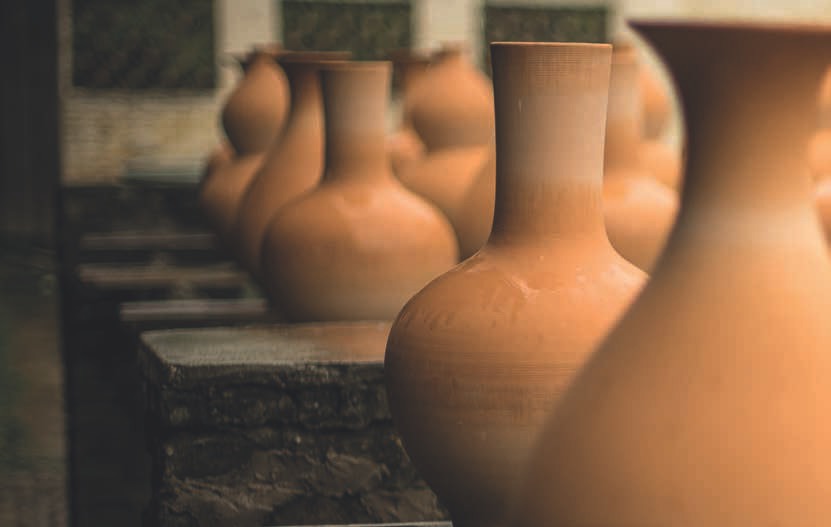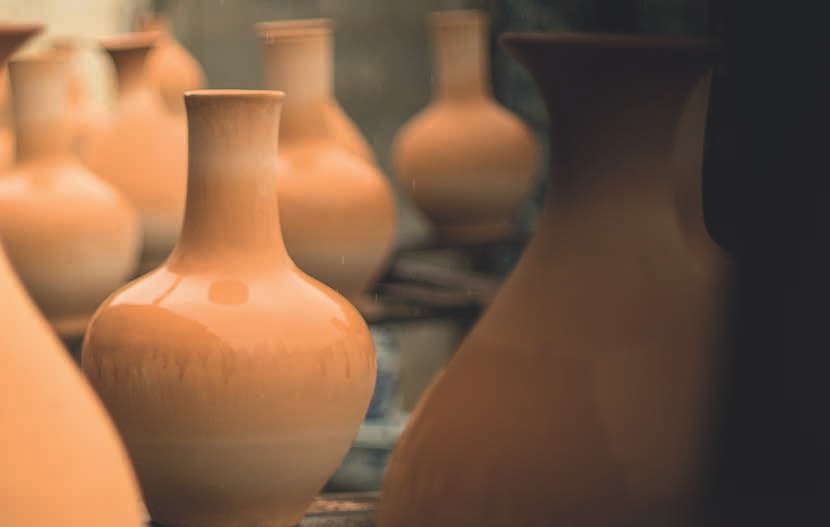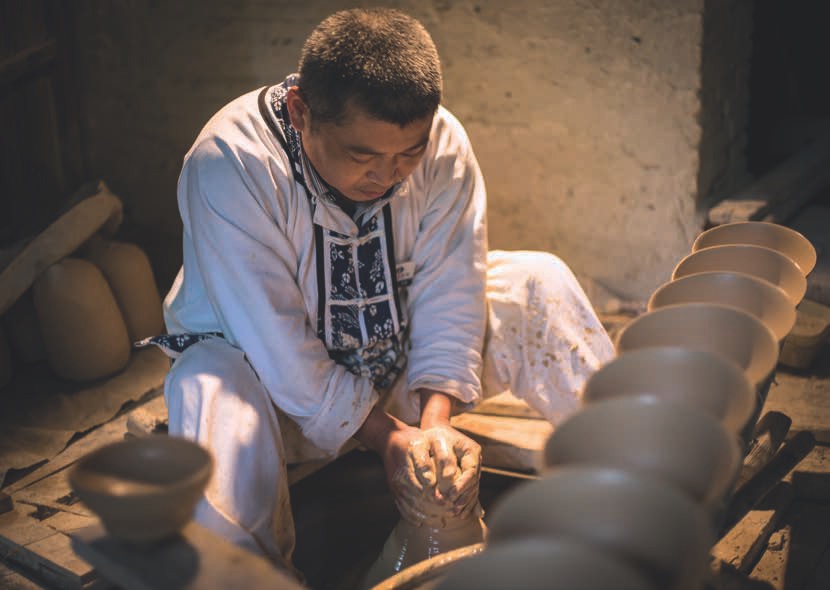
 |
|

Tea lovers all around the world are more than familiar with Yixing teapots, and many of us have dreamed of visiting this birthplace of zisha. And so many of us use cups, jars or plates from Jingdezhen, the hometown of porcelain. Both places are highly respected, and surrounded by legend by all potters and ceramic artists, teaware or otherwise. You can, therefore, imagine my excitement when I learned that this year's Global Tea Hut trip included these two historic towns! Of course, I knew that the time which we would spend visiting such deep places would be far too short to penetrate the surface of the wisdom and art accumulated there for hundreds of years, but even a glance at the clay, the chance to watch the hands of local artists, would be a refreshing wellspring of inspiration for me. I longed to touch the tools they use, smell the clay and see as much as possible: the curved lines of kilns, piles of wood slowly drying, clay and people - all dedicated to a life of teaware. My senses are always sharpened when close to potters, no matter how mundane and ordinary their lives seem to be. To put it mildly, I was excited to be there, even if just for a short while.
The story I would like to share with you is not the history of the ceramic industry in these two cities. There is more than two thousand years of ceramic history, and we spent just a day and half in Jingdezhen and a day and half in Yixing. After such a short visit, I don't feel qualified to talk about their history - like someone writing about Russia after spending half a night in the Moscow airport. So, I'll leave that to more qualified authors. What I would like to offer you here is my impression of the hundreds of shops, thousands of pots and millions of working hours we witnessed - a story of people creating a life from earth, of everyday alchemists who use water, fire and wind to alchemize mud into gold.
From one perspective, the porcelain from Jingdezhen and the purple-sand teapots from Yixing are situated really far from each other. The clays, as the bones of these two kinds of teaware, are so different from each other that the whole technology around them differs in every single step, from mining to clay-processing to the ware and firing. Traditional porcelain-ware was made on a wheel, and then extensively trimmed. Yixing pots are hand-built (or "slab-built," if you wish) and polished for hours. Yixing pots are left unglazed, while porcelain clay is painted and glazed. The kilns in Jingdezhen are huge pear-shaped "dragon kilns" with tall, wide chimneys, loaded from the front with one big firebox. The dragon kilns in Yixing are long, low and climb a hill, with almost no chimney, using multiple side-stokes instead. Though they are more different than alike, how are these two teaware towns alike?
What both these towns have in common is the vast amount of energy carried on for centuries, and an amassed lore of craftsmanship, as well as the accumulated and transmitted skill of countless unknown potters behind each piece. For centuries, pottery was collective work, carried out through the cooperation of whole villages working together in mining, clay production, teaware artistry, firing and even the merchants who represented the town to outside traders. Ceramic work has always been a very complex and wide field, where knowledge was handed down over generations. Every single step, from mining to firing, represents the lives of many masters and students who became masters themselves. In Yixing, as well as in Jingdezhen, there were masters of clay, pot-throwers, trimmers, painters, carvers and kiln masters - each with a lineage of craft and skill. When you see an old Yixing pot stamped by a famous artist, or a porcelain vase painted by a famous painter, you must remember that all their fame was built on the joint efforts of families, students and unknown craftsmen, without whom these masterpieces would not have been possible.
As I was walking around the ceramic museum in Jingdezhen, we came upon skilled craftsmen demonstrating how wares were made in the past, with a hand-turned wheel. I was amazed. And not just by the really cool show and the demonstration of skill, but also by the many small details I noticed - all the soft skills in the tools, shelves, firewood and other details. There were piles of clay ready to be used for today's work, which may create the rice bowls someone will be using a few hundred years from now in their kitchen. As the thrower was spinning his wheel, I thought about what would be left from this day in those bowls: his laughter and sore elbow, the morning rain and afternoon sun, forever imprinted into the malleable clay that absorbs whatever impression is around it.

Fine porcelain was always fired in saggars, which are chamotte clay cases, to protect the glazing and fine paint/glaze details from direct fire. When I saw those saggars stacked around like modern art sculptures, with fire marks and wonderful textures, I couldn't help but think about the hard work and mastery needed just to make these saggars. And once again I was deeply impressed by the accumulated knowledge needed to create such simple equipment and the little-honored craftsmen who spent their days making saggars to fire other men's masterpieces in.
When you walk within old kilns, you can feel the heat - the river of energy that once flowed through them. Today, Jingdezhen is still rightfully called the "Porcelain Capital," even though some of the old techniques have been lost. In ceramic communities, people say that you can find everything and anything possible in Jingdezhen. Artists and designers from all around the world, full of young and wild ideas, go to Jingdezhen to make it happen. The university there is the most important ceramics university in China. And it was nice to see new, young artists, galleries and approaches thriving there. As a potter, I would be happy to go back one day on my own, but this time for a longer period - to learn, work and create. Jingdezhen left me with dreams...
This was my second visit to Yixing and I had to smile to myself, knowing that I was as excited as the first time, just to walk around the closed-down mines others would find boring. We must have made quite the picture: three dozen foreigners trying to look behind walls which surround small hills where deep underground, mythical stones are hidden. What did we actually see? Just hills full of red stones, growing grass and wild trees. So why the sparkle in our eyes? Was it just our imagination? Or the connection to the Leaf? Maybe both, but the enthusiasm of our hosts, Master Zhou Qi Kun (周其坤) and his wife, Master Chen Ju Fang (陳菊芳), was real and everybody was touched by their joyful and selfless desire to share wisdom and hospitality with us, making us feel at home in Yixing.
The time we spent sightseeing at the old mines, the Dragon Kiln and museum was just like an appetizer before a feast. Many Yixing teapots relate experiences, and the evening's demonstration would add to our teapots forever. Master Zhou showed us not just how a chunk of clay becomes a glorious teapot, but, more importantly, what true mastery looks like. Two hours of quiet, focused creation with relaxed "effortless effort (wu wei, 無為)" energy mesmerized all of us. At the end of the trip, a few people from our group mentioned that, for them, this was the highlight of the whole trip. I was not surprised. His hands were so gentle and yet so powerful. Even though we saw just one part of the Yixing pot-making process, and Master Zhou apologized a couple of times for not doing it as well as he would like to (due to the lack of time), the demonstration was magical, like a shamanic dance, and yet somehow as natural as a tree growing. It was as if the pot had always been in that clay, destined to rise by the meeting of his hands and the work of his deft movements. From the inside out, fruit is grown - from stones mined underground, an empty space in the shape of a teapot is made ready for our tea brewing, another extension in the long line of arts that leads to a cup of tea.
When we clean our tea table, neaten our chabu and put down our favorite Yixing teapot, next to simple, blue-painted cups from Jingdezhen, we are often so familiar with this act that we don't think too much about all the effort and tradition that has gone into that moment, literally for centuries. These two kinds of teaware have played together for a long time, enhancing myriad cups of tea, and making our own tea settings complete and our lives more beautiful. That is why we could say that ceramics are the oldest medium of interactive art there is in the world. Art is here to enrich our lives and to communicate without words, often things that can't be communicated verbally anyway. That is why even a small cup of tea can sometimes say more than a book of words. When part of a tea ceremony, these simple cups and pots, with centuries of art and craft within their soul, bring greater depth and energy to our rituals than we often remember. Having traveled to these glorious cities, I won't forget that depth for many a session.

